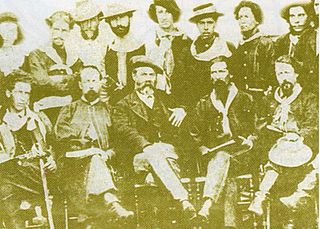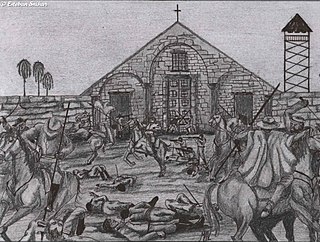
The Battle of Acosta Ñu, also known as the Children's Battle in Paraguay and the Battle of Campo Grande in Brazil, took place on 16 August 1869. It was the last major engagement of the Paraguayan War between the Triple Alliance and Paraguay. The 3,500 poorly armed Paraguayans, mostly boys between nine and fifteen years old, old men and wounded combatants, confronted 20,000 Brazilian and Argentine veteran soldiers.

The Uruguayan Civil War, also known in Spanish as the Guerra Grande, was a series of armed conflicts between the leaders of Uruguayan independence. While officially the war lasted from 1839 until 1851, it was a part of armed conflicts that started in 1832 and continued until the final military defeat of the Blancos faction in 1904.

The Battle of Arroyo Grande took place on 6 December 1842 and was a major battle of the Uruguayan Civil War.

Cisplatina was a Brazilian province in existence from 1821 to 1828 created by the Luso-Brazilian invasion of the Banda Oriental. From 1815 until 1822 Brazil was a constituent kingdom of the United Kingdom of Portugal, Brazil and the Algarves. After the independence of Brazil and the formation of the Empire of Brazil the Cisplatina province remained part of it. In 1828, following the Preliminary Peace Convention, the Cisplatina province became independent as Uruguay.

The Revolution of the Lances occurred in Uruguay from September 12, 1870 to April 6, 1872.

The Portuguese conquest of the Banda Oriental was the armed-conflict that took place between 1816 and 1820 in the Banda Oriental, for control of what today comprises the whole of the Republic of Uruguay, the northern part of the Argentine Mesopotamia and southern Brazil. The four-year armed-conflict resulted in the annexation of the Banda Oriental into the United Kingdom of Portugal, Brazil and the Algarves as the Brazilian province of Cisplatina.

The Brazilian War of Independence was an armed conflict that led to the separation of Brazil from the United Kingdom of Portugal, Brazil and the Algarves. The war was fought across various regions of Brazil, including Bahia, Maranhão, Pará, Piauí, and Cisplatina, with naval battles occurring along the Atlantic coast. Brazilian forces, consisting of regular troops, local militias, and a hastily assembled fleet, defeated the Portuguese garrisons to establish the Empire of Brazil under emperor Pedro I. The war formally ended with the Treaty of Rio de Janeiro in 1825, in which Portugal recognized Brazil's independence.
The Battle of Ibicuí River took place between the Luso-Brazilian forces under Brigadier Chagas dos Santos and the Federal League forces under the command of General Sotelo. The Luso-Brazilians were victorious and inflicted very high casualties on Sotelo's army.
The Battle of Santa Ana took place between the Luso-Brazilian forces under the command of Alexandre Queirós in Rio Grande do Sul, modern-day Brazil. After the Luso-Brazilian attack, oriental leader José Gervasio Artigas attempted to take the battle to the invading forces by invading Brazil. The battle lasted for 3 hours and ended with a Luso-Brazilian defeat.
The Battle of Ibiraocaí, was fought between an army of the United Kingdom of Portugal, Brazil and the Algarves and the forces of José Gervasio Artigas commanded by José Antonio Berdún. The Luso-Brazilians were victorious.
The Battle of Carumbé, was fought between an army of the United Kingdom of Portugal, Brazil and the Algarves and the forces of José Artigas. The battle resulted in a decisive Luso-Brazilian victory, as Artigas' plans to invade Brazil were permanently ruined.
The Battle of India Muerta took place between the Luso-Brazilian forces under the command of Sebastião Pinto de Araújo Correia against the artiguists led by Fructuoso Rivera in Rocha, present-day Uruguay. The battle lasted for four and a half hours and ended in a Luso-Brazilian victory.
The Battle of Sauce of 1816 took place between the Luso-Brazilian forces under the command of Pinto de Araújo Correia in Arroyo Oriental, modern-day Uruguay. The engagement resulted of the encounter between the Luso-Brazilian forces that had previously defeated the men of Fructuoso Rivera.
The Battle of Tacuarembó took place between the Luso-Brazilian forces under the command of José de Castelo Branco Correia, Count of Figueira, and the Artiguist forces of Andrés Latorre in Tacuarembó, modern-day Uruguay.
The Battle of Catalán was fought between the Luso-Brazilian forces under the command of Luís Teles da Silva Caminha e Meneses, the Marquis of Alegrete, and the artiguistas commanded by Andrés Latorre in Arroyo Catalán, present-day Uruguay.
The Battle of Pablo Perez was an encounter between the Luso-Brazilian forces under the command of Bernardo da Silveira and the Artiguist forces of Fernando Otorgués in Cerro Largo, modern-day Uruguay.
The Battle of Arapey was an encounter between the Luso-Brazilian forces under José de Abreu Mena Barreto and the Artiguist forces led by José Artigas, the independentist caudillo himself, in Salto, modern-day Uruguay.

The Battle of Apóstoles was an encounter between the Luso-Brazilian forces under Francisco das Chagas Santos and the Artiguist forces led by Andrés Guazurary, popularly known as Andresito, in Apóstoles.
The Battle of San Carlos took place between the Luso-Brazilian forces under the command of Francisco das Chagas Santos and the Misionero forces led by Andrés Guazurary, popularly known as Andresito, in San Carlos, modern-day Argentina.

The Battle of Sarandí was fought on 12 October 1825, in the vicinity of the Arroyo Sarandí in Uruguay, between troops of the Banda Oriental and the Empire of Brazil. It resulted in a decisive victory for the Orientals.







